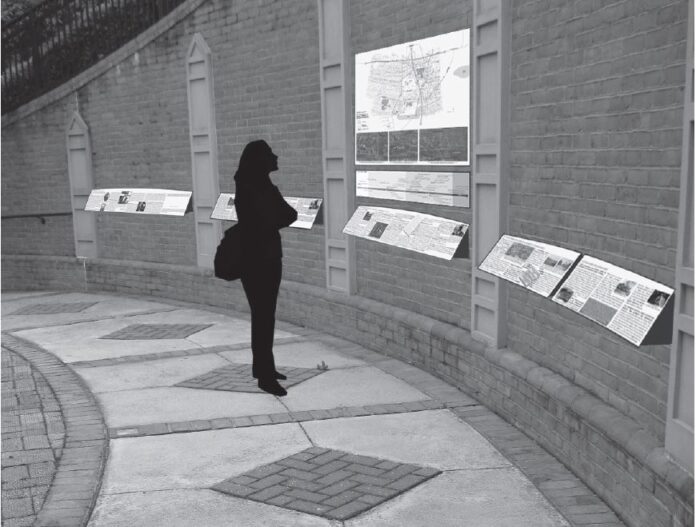 The Gainsborough Southwest Community Organization has dedicated eight Interpretive History Panels erected as Phase I of the Historic Gainsboro Walk.
The Gainsborough Southwest Community Organization has dedicated eight Interpretive History Panels erected as Phase I of the Historic Gainsboro Walk.
The panels are located on the wall in the Wells Avenue Plaza across from Hotel Roanoke and relate the significant history of one of Roanoke’s earliest neighborhoods, the Town of Gainesborough, chartered in 1835 to the settlement and evolution of Northeast and Northwest Roanoke; and the notable contributions of African- American citizens and leaders from the area. The public is invited to attend.
The dedication celebration included a guest speaker and invited guests who grew up in the neighborhood or are descendants of leaders highlighted in the panels. In making the announcement celebrating completion of the panels, Gainsborough Southwest Neighborhood Organization President Constance Crutchfield said, “This project honors our past and informs citizens and visitors of the significant contributions of our neighborhood residents to the history of our community and the City. This dedication is especially appropriate during Black History Month in that it recognizes the significant heritage and contributions of African American residents and represents a great accomplishment for our neighborhood organization and the City of Roanoke.”
The interpretive history panels in the Wells Avenue Plaza represent the first phase of the neighborhood walking tour project which eventually will extend to Henry Street, Gainsboro Road and Gilmer Avenue, identifying key historic, architectural, and cultural sites in the neighborhood. The Gainsboro History Walk project is an initiative of the Gainsborough Southwest Community Organization to tell the important history and evolution of Gainesborough, Roanoke’s first chartered town, established in 1835, predating the coming of the railroad and the establishment of the 1872 Town of Big Lick which later became Roanoke in 1882.
The historic Town of Gainesborough was platted near the intersection of today’s Orange Avenue and Williamson Road. The Gainsboro Neighborhood as we know it today actually lies just southwest of the original town and has been affected by evolving settlement patterns and by major road and redevelopment initiatives since the late 1950s. The neighborhood is known by many former residents as Northeast and Northwest.
Of particular importance to Roanoke and the region was that this once diverse, racially mixed neighborhood became a thriving, self-sufficient African-American community from 1900 to 1940 that attracted residents and business investors. A number of black civic, professional and business leaders from the neighborhood made significant local and regional contributions to religion, medicine, and education. Others provided national leadership to the civil rights movement in America.
The interpretive history panels have been many years in the making. Initially proposed as part of the widening and realignment of Wells Avenue in the 1990s, the plaza and sidewalk improvements were built, but the panels never completed. Two years ago, the Gainsborough Southwest Community Organization took on the challenge to develop the history panels working with a volunteer committee that included neighborhood residents, historians, and others interested in telling the important history of the area.
Alice Roberts noted that, “There are more historic markers and projects to come. This is Phase I.
Additional markers for important historic sites are planned along Wells Avenue, Henry Street, Gainsboro Road and Gilmer Avenue. In addition, the Committee is working on a historic walking tour for the area.”
A Neighborhood Development Grant, and an Arts and Culture Plan Implementation Mini-Grant from the City of Roanoke (with support from the Foundation for the Roanoke Valley), funded the panels. Other funding sources included private donations from citizens and the Roanoke Valley Preservation Foundation.
Gainsboro History Committee member and retired teacher and artist, Charlene Graves, added that, “Teachers will be able to use these panels as a foundation for their black history lessons. The contributions made by African-Americans from this community influenced social life, business development, and the advancement of civil rights locally, regionally, and nationally.”
Gainsboro History Committee Member Margaret Roberts added that, “These panels highlight the role models of our past for citizens today, thereby promoting cultural understanding for future generations.”

